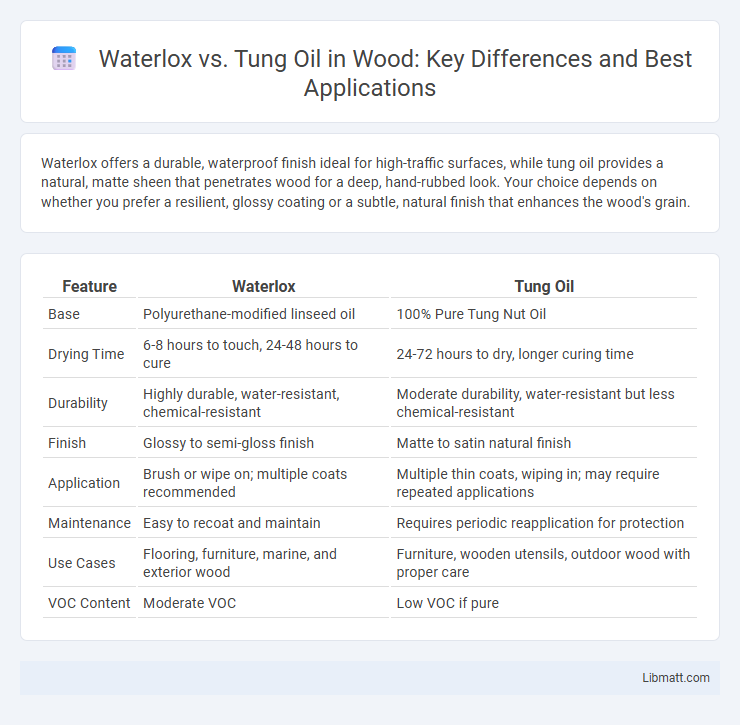Waterlox offers a durable, waterproof finish ideal for high-traffic surfaces, while tung oil provides a natural, matte sheen that penetrates wood for a deep, hand-rubbed look. Your choice depends on whether you prefer a resilient, glossy coating or a subtle, natural finish that enhances the wood's grain.
Table of Comparison
| Feature | Waterlox | Tung Oil |
|---|---|---|
| Base | Polyurethane-modified linseed oil | 100% Pure Tung Nut Oil |
| Drying Time | 6-8 hours to touch, 24-48 hours to cure | 24-72 hours to dry, longer curing time |
| Durability | Highly durable, water-resistant, chemical-resistant | Moderate durability, water-resistant but less chemical-resistant |
| Finish | Glossy to semi-gloss finish | Matte to satin natural finish |
| Application | Brush or wipe on; multiple coats recommended | Multiple thin coats, wiping in; may require repeated applications |
| Maintenance | Easy to recoat and maintain | Requires periodic reapplication for protection |
| Use Cases | Flooring, furniture, marine, and exterior wood | Furniture, wooden utensils, outdoor wood with proper care |
| VOC Content | Moderate VOC | Low VOC if pure |
Understanding Waterlox and Tung Oil
Waterlox is a durable, tung oil-based finish known for its protective qualities and water resistance, commonly used on hardwood floors and furniture. Tung oil, extracted from the seeds of the tung tree, is a natural drying oil that penetrates wood deeply to enhance its grain and provide a flexible, water-resistant finish. Your choice between Waterlox and pure tung oil depends on the level of durability and protection required for your woodworking project.
Key Differences Between Waterlox and Tung Oil
Waterlox features a resin-modified tung oil formula that provides a durable, water-resistant finish ideal for high-traffic surfaces, whereas pure tung oil is a natural finish that penetrates wood for a flexible, matte appearance but requires prolonged curing and multiple coats. Waterlox cures faster and forms a harder, more protective film compared to tung oil's slower drying time and softer surface. Waterlox is preferred for projects demanding long-term durability, while tung oil suits applications prioritizing natural aesthetics and ease of maintenance.
Composition and Ingredients
Waterlox is a blend of tung oil and resins, creating a durable, water-resistant finish ideal for hardwood floors and furniture. Tung oil, derived solely from the nuts of the tung tree, is a natural drying oil that penetrates wood fibers but lacks the enhanced protective resins found in Waterlox. When choosing your finish, consider that Waterlox's combination of oil and resins offers superior hardness and moisture resistance compared to the pure, more natural composition of tung oil.
Application Methods Compared
Waterlox typically requires brush or roller application, providing a durable, glossy finish after multiple coats with drying times of 12-24 hours between layers. Tung oil is often applied with a cloth or brush in thin coats, allowing deep penetration into the wood, with longer curing times of up to 7 days for optimal hardness. Waterlox forms a hard, protective surface on top, while tung oil enhances the wood's natural grain by soaking in and hardening within the fibers.
Drying and Curing Times
Waterlox typically dries to the touch within 6 to 8 hours and fully cures in about 7 days, offering a durable, water-resistant finish ideal for wood surfaces exposed to moisture. Tung oil requires a longer drying time, often taking 24 hours or more to dry between coats, with full curing extending up to 30 days, resulting in a natural, flexible finish. Your choice between Waterlox and tung oil should consider the project's timeline and desired finish durability.
Finish Appearance and Sheen Levels
Waterlox provides a rich, glossy finish with a high sheen level that enhances wood grain depth and durability, making it ideal for surfaces needing a protective, polished look. Tung oil penetrates the wood to deliver a natural, matte to satin finish that subtly highlights texture without overpowering the wood's natural character. Your choice between Waterlox and tung oil depends on whether you prefer a more lustrous, durable surface or a softer, more natural appearance.
Durability and Water Resistance
Waterlox offers superior durability and water resistance compared to tung oil due to its unique blend of resin and linseed oil that creates a hard, protective finish. Tung oil, while providing a natural, penetrating finish, requires multiple applications and more frequent maintenance to achieve similar water resistance. For applications demanding long-lasting protection and resistance to moisture, Waterlox is generally the preferred choice.
Maintenance and Recoating Needs
Waterlox offers superior water resistance and durability, requiring less frequent maintenance and recoating compared to tung oil. Tung oil penetrates deeply but tends to wear faster, necessitating more regular reapplication to maintain protection and finish quality. For high-traffic surfaces, Waterlox's longer-lasting finish reduces labor and material costs over time.
Eco-Friendliness and Safety
Waterlox is formulated with low VOCs and natural oils, making it a more eco-friendly and safer option compared to traditional finishes. Tung oil, derived from the seeds of the tung tree, is biodegradable and non-toxic but may require multiple coats that increase solvent exposure. Your choice should consider the balance between durable protection and environmental impact, with Waterlox offering superior safety for indoor use.
Choosing the Right Finish for Your Project
Waterlox offers a durable, waterproof finish ideal for high-traffic surfaces like hardwood floors and countertops, providing rich color enhancement and long-lasting protection. Tung oil, derived from tung tree seeds, penetrates deeply to nourish wood, delivering a natural, matte finish suitable for furniture and decorative projects with less exposure to wear. Selecting between Waterlox and tung oil depends on desired durability, appearance, and application environment to ensure optimal wood preservation and aesthetic appeal.
Waterlox vs tung oil Infographic

 libmatt.com
libmatt.com